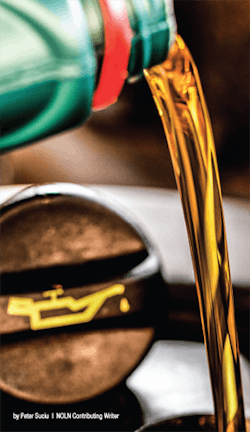The world is always changing, and with each year, new vehicle models hit the road — so it shouldn’t be surprising that the American Petroleum Institute (API) has also strived to stay in check with the changing times with its new oil standards. The new CK-4 and FA-4 performance categories in diesel engine oils will be introduced as the next generation specifications later this year.
API announced these new diesel oil standards will be licensed on December 1, 2016. This is an important step forward because it has been nearly a decade since the last API diesel engine oil category for North America was developed and introduced. Over the past 10 years, diesel engines have continually evolved, with vehicles obtaining improved fuel efficiency along with increased power output.
Moreover, new emission legislation is now scheduled for diesel-powered commercial transport vehicles for 2017 that will require reduced carbon dioxide emissions along with even greater fuel economy. As a result, there has been an increased need for a new performance level for lubricants, and the specification of these was referred to as the Proposed Category 11 (PC-11) throughout the development process.
With the finalization of these specifications, the new diesel oils are known respectively as API CK-4 and FA-4, and, as noted, these oils will be first licensable in December of this year.
The road to these oils was largely the result of regulations that called for reduced emissions and greater fuel economy, but it has been a long time coming. The new category developments actually began with a request from the Truck and Engine Manufacturers Association back in June 2011, when the trade group requested that a new specification for diesel engines would see the creation of two oil specs that were separate and distinct subcategories. The first would be to preserve historical heavy-duty oil criteria, while the other would provide greater fuel efficiency benefits.
In Summer 2011, API formed a team to develop the new oil category to replace the current CJ-4. At the time of this initiative, they thought it would be a five-year process with CK-4 being ready for January 2016, but there were delays in the process that pushed back the licensing availability to December 2016.
API’s New FA-4 Donut is Ready to Roll
To aid in educating about the new specifications, API has introduced a special Service Symbol Donut to make it easy to clearly identify FA-4 diesel oil. The new donut features a shaded section that is meant to differentiate API FA-4 diesel oils from CK-4.The API CK-4 Service Symbol will look the same as the current CJ-4 donut.
“The FA-4 donut was developed to help truck owners who need FA-4 oils easily recognize the oil and distinguish it from CK-4 oils,” said Kevin Ferrick, senior manager for engine oil licensing at API.
Two Diesel Specifications – Big Differences
Since the introduction of CJ-4 in 2006, there has been a great deal of changes to engine hardware — not least of which were new types of injection systems, as well as combustion temperatures and pressures, along with different metallurgy within the engines and new coatings. As such, API has been working on the two new distinct replacements for CJ-4.
“For operators, it will be an upgrade to the oil that they’ve grown accustomed to using,” Ferrick said. “The new upgrade is really overdue, but with this improved performance oil, it will protect truck engines on the road today.”
With two new diesel oils replacing CJ-4, it could be confusing to determine which is right for the engine, and that is where the donuts come into play.
“It will come down to what oil is recommended for their truck,” Ferrick added. “Service providers will need to confirm the oil recommended for a particular engine.”
One key point of distinction is CK-4 will be a backward-compatible oil, and can be used not only in commercial trucks but also in passenger cars, pickup trucks and off-road vehicles, including farm and construction equipment. CK-4 is thus intended to be the new oil for older diesel engines.
By contrast, the FA-4 oil likely won’t be recommended for older vehicles on the road, as API has noted it has not been developed to be backward-compatible. FA-4 is a low-viscosity formulation, which has the potential to further improve fuel economy of on-highway vehicles, but it isn’t meant for engines older than the 2016-2017 year models. However, whether it will be approved for use in older vehicles — and whether operators will need to stock both specs — will mostly depend on what OEMs decide is appropriate for their older engines.
“If someone is running an [older] engine today, there is no guidance at present for the OEM to say to use FA-4, but over time they may or may not determine that it could be used,” Ferrick explained. “Instead, those operators currently using CJ-4 should consider moving to CK-4 for the present time.”
It is largely expected that CJ-4 will transition to CK-4 quickly, while the roll out to FA-4 may be a bit slower. If there is confusion with two new oils being introduced, the best advice that Ferrick could offer to shops is to err on the side of caution – as CK-4 will fill the void where CJ-4 was used.
To clarify, CK-4 oils will be backward-compatible with all big-rig and pickup trucks, as well as off-road equipment that utilize the current CJ-4 oils. This includes off-road engines that demand high-temperature, high shear (HT/HS) capabilities of CK-4 formulations to further protect engines in typical off-road applications where there can be high-heat or high-load conditions. The CK-4 oils will offer improved oxidation stability, aeration control and resistance to viscosity loss — while FA-4 oils will adopt the same performance requirements at a lower viscosity.
FA-4 would likely be the choice of oils for those with semi-trucks, medium-duty and diesel pickup trucks, but only for 2016-2017 or newer models.
“If you’re uncertain, check with your engine manufacturer,” Ferrick said. “For shops, the easiest way to say it is these are new oils. CK-4 is an improvement over CJ-4, and it will provide better performance over CJ-4 oils.”
When in doubt, the best thing to do is to follow the guidelines set by the OEMs.
Gasoline Oil Specs — When to Expect GF-6
Diesel vehicles aren’t the only ones that will be seeing a new oil specification roll out soon. Gasoline oil specifications are being updated as well, and in the not-too-distant future, the current GF-5 will be replaced by GF-6. Much of the driver for a new International Lubricant Specification Advisory Committee (ILSAC) specification results from Corporate Average Fuel Economy (CAFE) Standards that were put into effect by the National Highway Safety Administration (NHTSA) in 2012. CAFE has called for a fleet-wide average 54.5 mpg by 2025 in the United States.
This challenge requires approximately a 5-percent annual improvement in fuel economy in all new passenger vehicles, and part of this will involve a comprehensive improvement in overall engine design, while the type of oil being used will be crucial as well. GF-6 will include advanced lubrication technology for enhanced efficiency and engine protection — but reaching these goals will not be without challenges.
“The development of GF-6 has been delayed,” Ferrick said. “Right now, it will be introduced by sometime in the second quarter of 2018. So we’re not looking at it arriving this year or even next year.”
The delays are largely due to snags in engine test development, but at the quick lube level, shops just need to know GF-6 is on the horizon.
This new specification upgrade was created to reflect the needs of new engine technology including gasoline direct injection (GDI) as well as turbocharged GDI (TGDI) engines, while providing improvement in lubricant performance. This will further protect the engine in harsher conditions, while ensuring higher fuel economy targets. This is important because it has been estimated that by 2020, 39 percent of passenger cars produced globally will run on GDI/TGDI engines — and this technology requires higher performance engine oils compared to what GF-5 offers today.
“OEMs will likely be much more explicit in their engine oil recommendations when GF-6 is introduced,” Ferrick said. “The days of everyone using the same viscosity gradeare going by the wayside.”
Just as diesel oils are seeing a split, so too will the gasoline oils, which will include a GF-6A spec — or the traditional upgrade to GF-5 — and GF-6B — which would encompass light viscosity oils, such as 0W-16.
“We will likely see two gasoline standards come out, just like there are two diesel oils,” Ferrick said. “But there are delays, so it will be a while in coming.”
Update to GM’s dexos
This year will also see an update to General Motors’ dexos specification for passenger vehicles. Introduced in calendar year 2010 for vehicle year 2011 cars and trucks, the first generation of the General Motors’ oil specification is now known as dexos:1 2010, and later this year GM will transition to the dexos:1 2015 spec.
“It was introduced at the end of last year and is now going through the final approval process,” said Eric Johnson, GM’s industry liaison for engine oil and fuels. “The significant change from a formulating standpoint is in the pre-ignition test and how it can better protect turbocharged vehicles. That has been a continuing industry concern, and dexos:1 2015 will address these concerns.”
GM introduced the dexos specifications to ensure that the oil meets the demands of today’s evermore-complex engines, which need to meet stricter emission regulations and increased fuel economy standards. The automaker enacted the specs to further create a global standard for its vehicles, so engines would be protected worldwide.
“Engines today are made in different plants and go to different regions, and it is beneficial to our customers that they have the best oil out there for today’s engines,” Johnson added.
GM has further developed its own testing, making sure the oil can protect today’s turbocharged vehicles. Moreover, GM’s new specifications are designed to exceed some industry standards, including the NOACK Volatility Test — also known as ASTM D-5800, which determines the evaporation loss of lubricants during high-temperature service.
“Our spec limit is 13 percent,” Johnson noted, “whereas the industry is 15 percent.”
GM has also surpassed other industry testing, exceeding even the Sequence IIIG Test, which can further evaluate automotive engine oils for certain high-temperature performance characteristics like oil thickening, oil consumption and engine wear.
With its second generation of dexos:1, GM has utilized four additional engine tests that include the GM Stochastic Pre-Ignition (SPI) Test, which evaluates the lubricant’s ability to prevent low-speed or stochastic pre-ignition; the GM Aeration Test, which evaluates a lubricant’s ability to resist aeration during varying durations of engine operation; the GM Turbocharger Deposit Test, which evaluates the lubricant’s resistance to coking and buildup during extreme temperature operation; and the GM Oxidation and Deposit (GMOD) Test, which is under development and will replace the current Sequence IIIG test.
“We do this to ensure that the consumer has the best oil for their GM car,” Johnson said.
As regulations call for greater fuel economy and lower emissions, the industry will move forward with oils that are much more specific to the changing engines of today and tomorrow. This could mean that shops will have to ensure their shelves are stocked with oils to address changing engine technologies and oil specifications.
About the Author

Peter Suciu
Peter Suciu is Michigan-based writer and NOLN freelance contributor who has contributed to more than four dozen magazines, newspapers and websites. He lives in the land of cars not far from one of Henry Ford's estates.
